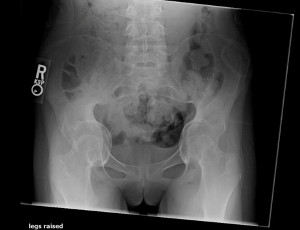Description
Marfan Syndrome is a genetic disorder that affects the connective tissue. A genetic disorder is a problem that a person is born with and can be passed down in a family. Connective tissue acts like the glue that holds certain types of cells together in our body. People with Marfan syndrome tend to be very tall and slim. They may have loose joints, as well as problems with their heart, spine, and eyes. These problems tend to appear as a person gets older.
Symptoms, Examination and Testing
Height and body type may be the first clue to diagnosis. A review of family history is often helpful. Physical exam will include looking at the back and chest. People with Marfan Syndrome may have an abnormal rib cage (pectus deformity). They may have a curved spine (scoliosis). The orthopedic doctor may check certain tests to see how loose some joints are. He or she may also measure wingspan (length from the tip of one index finger to the tip of the other with arms stretched out). X-rays of the back and hips can be helpful for looking for other signs.
Your doctor may refer your child to a genetics doctor. This doctor will review family medical history and perform simple measurements and tests. He or she may suggest genetic testing. Other doctors such as an ophthalmologist (eye doctor) and cardiologist (heart doctor) may get involved as well to do eye and heart exams.
Treatment
Spine:
About 60% of children with Marfan Syndrome will develop a curve in their spine called scoliosis. Treatment can involve monitoring, bracing, or surgery. Sometimes there can be a condition called
spondylolisthesis where one bone in the low back can slip over another. Most patients are followed closely during growth with exams and X-rays.
Hips:
Because this syndrome affects the “glue” in our bodies, some people can have an issue with their hips called “protrusio.” This means the hip sockets can be too deep and limit motion of the hips. This often causes pain and stiffness. This can be seen with X-ray. People with this problem sometimes get arthritis. They may need hip replacements when they get older.

 Feet:
Feet:
Loose ligaments can cause flat feet. This is often treated with shoe inserts.
Chest:
Deformity of the chest wall can sometimes lead to problems with breathing. If severe, this can be corrected with surgery.
Eyes:
Marfan syndrome can cause many problems with the eyes. Patients need an eye exam quickly if there is any concern and need to be followed every year.
Heart:
The most dangerous part of Marfan Syndrome is that it can cause issues with the heart, heart valves, and major blood vessels (aorta). The heart may not pump properly. There can also be enlargement of the base of the largest blood vessel (aortic root aneurysm). An examination by a cardiologist (heart doctor) is needed and patients are followed very closely. Treatment can sometimes involve medications and/or surgery. People with heart valve problems may need to take an antibiotic medicine before they go to the dentist.
Outcomes
If this condition is found, patients can lead normal lives with a few limits. There are certain doctors that will need to see you at least every year to look for any problems that need treatment. One very specific limitation for people with Marfan Syndrome is exercise. Because of the heart problems, patients should only do low-intensity exercise such as swimming and biking. High intensity, fast start/stop, or contact sports such as weight lifting, soccer, sprinting, or football should be avoided to protect the heart/aorta and eyes. Also discuss exercise with your doctor before starting a new activity.
More Information
Condition QR Code:

What is Marfan Syndrome?
Marfan Syndrome is a genetic disorder that affects the connective tissue. It may run in a family or happen out of the blue.
What causes Marfan Syndrome?
It is caused by a defect in the fibrillin gene, which causes a problem with one of the proteins that helps hold together certain types of tissue, such as bone and blood vessels.
Can my child catch Marfan Syndrome?
No. It is something that people are born with. However, many of the symptoms only show up as a child gets older.
How is the diagnosis made?
Marfan Syndrome is usually diagnosed first with history and physical exam. Diagnosis also involves a heart and eye exam. It can often be confirmed with genetic testing.
What organs can Marfan Syndrome affect?
This syndrome can affect the eyes, heart, lungs, spine, and musculoskeletal system.
Will my child need surgery?
As a child with Marfan Syndrome grows and develops, there is a chance that issues may arise that could require surgery. This can include treatment for heart valves and aortic aneurysm, eye problems, scoliosis and chest wall deformity, or hip problems.
Does my child have any restrictions?
Yes. Once a diagnosis of Marfan Syndrome is made, you should have a thorough discussion with your doctors about exercise. In general, high impact activities, quick start/stop activities, or contact sports are not recommended because of serious risks to the heart and eyes. Most low impact activities such as swimming or bike riding can be done safely.
Is there a cure for Marfan Syndrome?
No, but with early diagnosis and good medical care, young people can lead normal lives with near normal life expectancy.

 POSNA.org
POSNA.org


